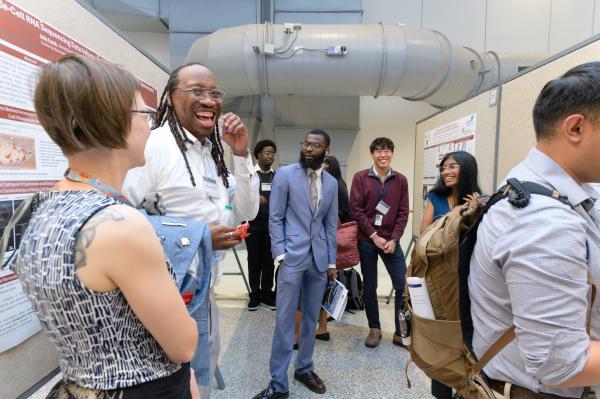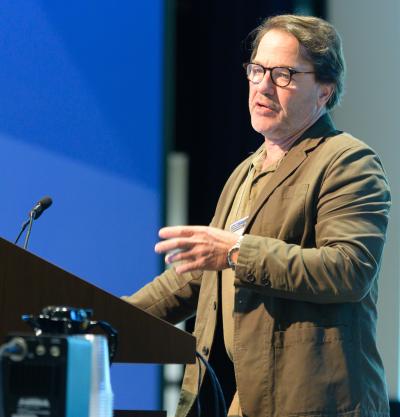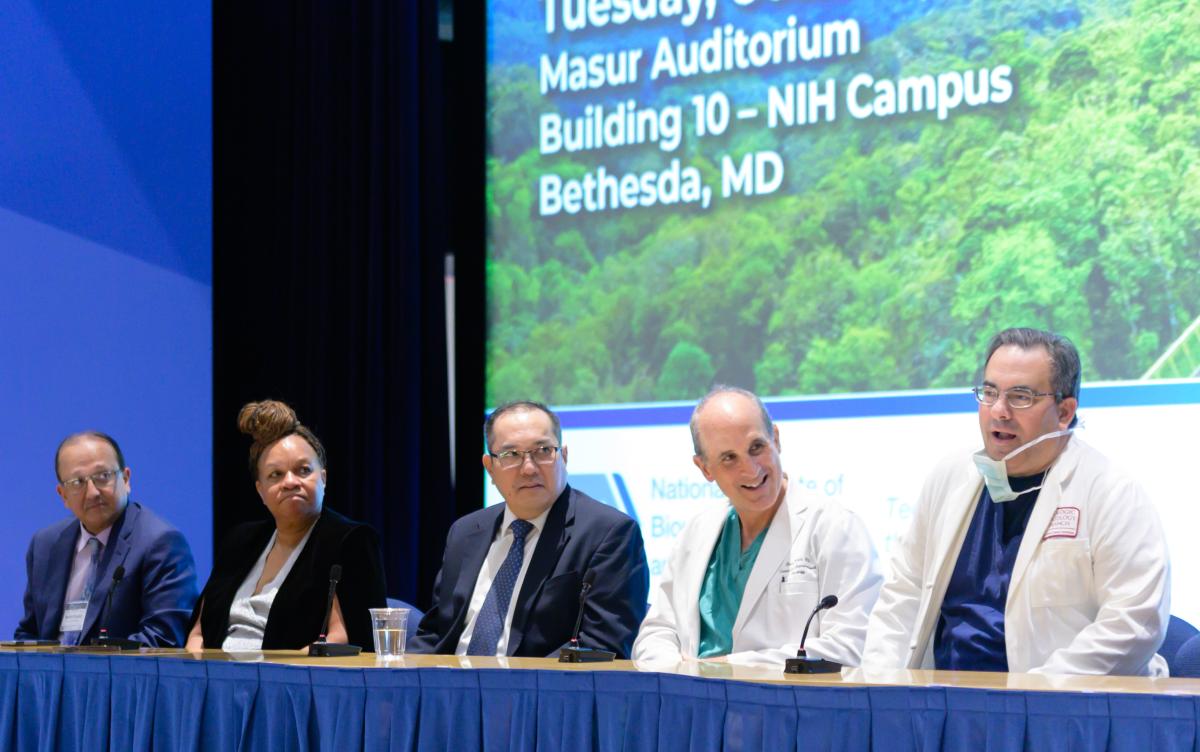Building Bridges: It’s What Engineers Do
NIBIB-led Conference Leveraged Partnerships Across Engineering, Technology, and Biomedical Research
BY THE NIH CATALYST STAFF
Fantastic advances are happening in the field of biomedical engineering. Bio-integrated prosthetics now allow people with lost limbs to regain mobility and independence; precision imaging and artificial-intelligence-guided analysis can identify the onset of cancer and heart disease; nanoparticles deliver targeted therapy directly to diseased tissue, minimizing side effects; and rapid progress in tissue regeneration is reversing damage to bone, cartilage, and muscle. And in this issue of the NIH Catalyst, we report on the first FDA-approved gene therapy, an advancement developed right here at the NIH for sickle cell disease.

CREDIT: MARLEEN VAN DEN NESTE
NIBIB Director Bruce Tromberg and BETA Center Director Manu Platt discuss the day’s agenda moments before being joined by NIH Director Monica Bertagnolli.
Scientists see this all as the beginning of a new medical revolution. On October 22, 2024, the NIBIB hosted a daylong conference on the NIH campus, “Bridges Across NIH and the Broader Engineering Community,” to tap into this excitement and enrich the NIH intramural research program with expertise from medically minded engineers within and beyond the NIH.
Hundreds of scientists and engineers attended—many visiting the NIH for the first time. The NIH conference was timed to coincide with the Biomedical Engineering Society (BMES) annual meeting in Baltimore.
“To me, this is what biomedical engineering is all about and what drew me to the field in the first place,” said Manu Platt, an NIBIB senior investigator who directs the Center for Biomedical Engineering Technology Acceleration (BETA Center) and who organized the meeting. “People from all walks of life and [who have] many different types of technical training in medicine, biology, chemistry, and the multiple engineering specialties, bringing their interests and expertise together to solve biomedical problems across the human condition. This is the power of bringing community together.”
The seeds of this conference date back more than four years when Bruce Tromberg arrived from University of California at Irvine in 2019 to serve as NIBIB director. Tromberg began planning what he called an NIH Bioengineering Festival for March 20, 2020. The emergence of COVID-19 thwarted that conference, but two rather significant and related developments happened in its place that would nevertheless put NIBIB in the national spotlight.
The first was the creation of the RADx® program, with a name so good that we had to register it as a trademark. RADx® stands for Rapid Acceleration of Diagnostics, an NIH-led and NIBIB co-coordinated program to develop, validate, manufacture, and deploy at-home and point-of-care COVID tests. RADx® Tech, an NIBIB subprogram to find solutions to health care problems beyond COVID-19, demonstrates the very core of the NIBIB mission: “To transform, through technology development, our understanding of disease and its prevention, detection, diagnosis, and treatment.”
The second development was the creation of the NIBIB-led BETA Center. Launched in 2023, the BETA Center is a biotechnology resource and catalyst for NIH intramural researchers akin to the successful “bench-to-bedside” concept—but here, NIBIB brings together scientists and engineers across NIH to collaborate in an iterative process to perfect a tool or technique. The BETA Center has since enlisted more than 100 intramural researchers from 16 ICs to join as BETA Center affiliates.

CREDIT: MARLEEN VAN DEN NESTE
More than 100 researchers presented their work…and had a little fun…during the two poster sessions on the FAES Terrace.
The Building Bridges conference was a natural extension of RADx® Tech and the BETA Center, “a bit of a coming-out party to the broader community,” Platt said. “I attended the BMES conference afterwards and heard continuous positive feedback from those who attended the day, and even more from people who wish they had attended because of the connections and science they heard [about] from others that did participate.”
NIH Director Monica Bertagnolli, who has an undergraduate degree in engineering from Princeton University (Princeton, New Jersey), spoke with clear passion for the field in a fireside chat with Tromberg and Platt at the outset of the day. “As NIH director, my lodestar is this principle: Our work is not finished when we deliver scientific discoveries. Our work is only finished when people are living long and healthy lives. And that’s what engineering helps us do,” she told the audience.
Areas ripe for bioengineering expertise include diagnostic tools, particularly for those in rural communities and women who live in “maternal health deserts,” and methods to detect lingering viruses, such as those thought to cause long COVID symptoms, Bertagnolli said, to bridge the gap between discovery and care.

CREDIT: MARLEEN VAN DEN NESTE
John Tisdale, an NHLBI senior investigator, presented his innovative work on bone marrow transplants and gene therapy for sickle cell disease.
By Tromberg’s estimate, between 14% and 15% of the NIH budget supports bioengineering research. That’s approximately $7 billion, far more than NIBIB’s $440.6 million budget, and testament to the importance of NIBIB serving as a bridge—a bridge between scientists and engineers, between doctors and patients, and between experts and junior biomedical engineers.
John Tisdale, an NHLBI senior investigator who directs the Cellular and Molecular Therapeutics Laboratory, delivered the day’s first plenary talk on the aforementioned sickle cell gene therapy. Other conference talks and breakout sessions reflected the diversity of the field: bioimaging, probe development, drug delivery, 3D bioprinting, orthopedics, gene therapy, artificial intelligence, and more.
Download the full agenda and watch the archived main stage talks at links provided here.
Hot off this successful conference, Platt said the BETA Center, which is located on the Bethesda campus, will continue to grow in 2025 with several collaborative opportunities:
- A BETA Center Makerspace is opening in January. NIH researchers can directly access rapid fabrication equipment including 3D printers and a laser cutter. Space, equipment, and supportive staff will be in Buildings 10 and 13.
- The BETA Center additionally now offers expertise in soft biomaterials with a team member who can assist labs interested in using biomaterial strategies but who had felt the bar was too high to try on their own.
- Similarly, the BETA Center now has expertise in computational and systems biology modeling to lower the barrier of entry for labs looking to use more mathematical approaches to analyze complicated biological systems.
- Workshops to educate investigators on specific techniques will be coming soon.
- Also on the horizon, the BETA Center intends to host sabbaticals for external collaborators to share their expertise and learn from NIH staff.

CREDIT: MARLEEN VAN DEN NESTE
Pictured from left to right at the afternoon panel discussion on innovation and working with industry are Rashid Bashir (University of Illinois at Urbana-Champaign), a panelist and later “extramural” keynote speaker; Cherie Butt (Biogen), Vincent Ho (Uniformed Services University of the Health Sciences), Brad Wood (CC), and Peter Pinto (CC).
Want to connect? Platt and his team, which includes Nicole Morgan, a physicist at NIBIB and BETA Center deputy director, hosts monthly idea-swapping meetings. Join their LISTSERV newsletter by e-mailing BETACenter@mail.nih.gov or linking to BETACENTER-ANNOUNCEMENTS.
This page was last updated on Friday, January 3, 2025
